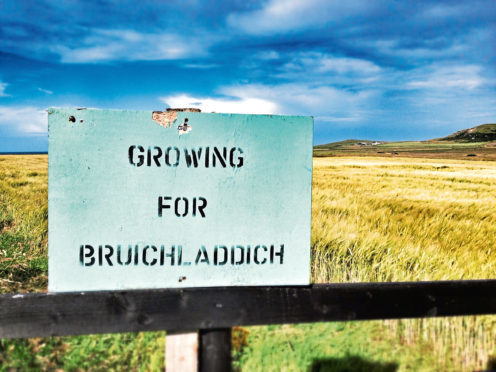While there is no legal requirement to source Scottish grain to produce Scotch whisky, most distilleries look to their homeland first for malting barley.
The vast majority – almost 90% – of the industry’s barley requirements are currently sourced in Scotland but some producers are taking it one step further and creating spirit made with nothing but 100% Scottish grain.
Bruichladdich on Islay has been pursuing this philosophy since it was re-opened by two former wine merchants whose expertise lay in fine French burgundy and who believed in the French notion of terroir, where the relationship between the land, the raw ingredient and the grower is considered second nature.
And it’s an ideology that has apparently worked out well, not only for the company and its customers but for local farmers too who benefit from a premium rate and steady market.
“Back when the decision was first made to only use Scottish grain, consumer perceptions were different. “We were ahead of our locavore time,” says Bruichladdich spokesman Christy McFarlane. “Now the modern day spirit buyer is increasingly aware of where their products come from and how they’ve been made.”
Today the distillery’s malt is guaranteed grown in Scotland and, in certain cases, they can pinpoint the exact farmer and the precise field in which the barley was raised.
“After all, we believe it’s called Scotch for a reason,” adds Christy.
Production director Allan Logan currently works in partnership with 17 growers on Islay, following a project that began in 2004 with just one farmer and one field.
“It’s grown into this huge success,” says Christy.
“We’re proud to be offering an opportunity to the local community to diversify into different areas of agriculture, which in the summer of 2017 expanded to growing rye on the island.
“Our partnerships with these farmers are not just about us growing malting barley locally, but also about having a meaningful economic impact on our island community.”
Bruichladdich offers farmers a premium for their grain. If they didn’t, the producers simply wouldn’t grow for them.
“The growing conditions on the west coast are gruesome, resulting in a lower tonnage per acre,” says Christry.
“This is partly due to the cold wet weather but also due to damage by pests such as geese and deer. There are also allowances made on higher levels of nitrogen and in the moisture content than is commonly accepted for mainland barley, but really what we’re looking for is a flavourful grain. It doesn’t interest us to stick to the usual parameters.”
When asked about sourcing, the Scotch Whisky Association said: “Given factors such as unpredictable weather, it is vital that producers have the choice of where to source the optimum grain to produce a consistently high quality product.”
And Gavin Dick, knowledge exchange manager for cereals and oilseeds at the Agriculture and Horticulture Development Board, acknowledges: “Scottish farmers produce the highest quality malting barley and it’s in the best interest of industry to use as much of it as possible.
“Most distilleries take the Scottish first approach to sourcing their barley, which is sensible as it ensures a high quality local supply, rather than having to import from further afield.
“It is also important to the farmers as growing for malting means they take a hit on yield as they have to limit their use of nitrogen, so they want to know they have a secure market for their crop.”
So would Bruichladdich encourage others to follow its lead?
Christy says: “It’s not really for us to dictate or demand anyone else to place the same level of importance on the provenance of their spirit.
“It would be great if others took the same initiative in working with their local community though. Remaining Islay-centric in everything we do means we’re still the largest private employer on the island, which for a distillery that produces 1 million litres per year, is pretty incredible.”
At the other end of the country, Annandale Distillery also supports the 100% Scottish ethos.
Co-owner, Professor David Thomson, says: “We believe that all of our production has been made with Scottish barley since we re-started in November 2014.” He says he advocates supporting Scottish farmers where possible, provided they can supply high-yielding varieties of the appropriate quality.
However just how significant the use of 100% Scottish grain is to the end product remains a subject for debate.
While Prof Thomson believes the notion that a product made with Scottish ingredients undoubtedly contributes to its provenance, he says: “It probably makes no difference at all to the quality or sensory characteristics of the whisky.”
On the same issue, Christy from Bruichladdich says: “In terms of flavour, it’s hard to say. We’re running a distillery not a laboratory, and there are differences between the flavour in organically grown barley or the sugary fat of bere barley.
“Our exploration of barley has led us in many different directions, from distilling organic barley, to resurrecting ancient landrace in our bere barley and has even included regional trials, which involves growing the same varietal in four different areas of Scotland. Exploring the influence of barley on the final whisky will continue to be a hugely important part of what we do for decades to come.”
